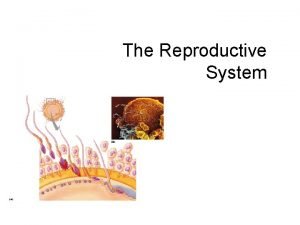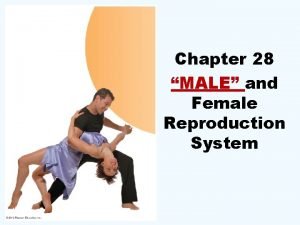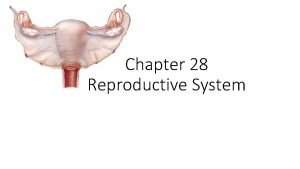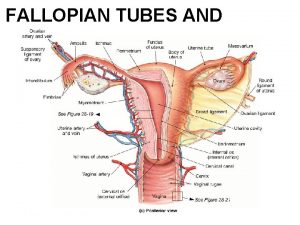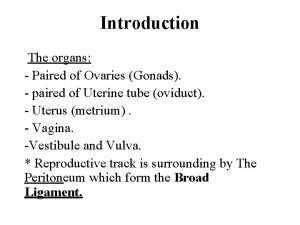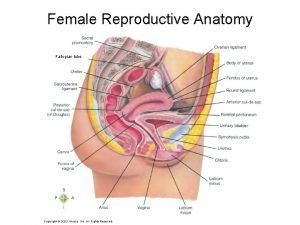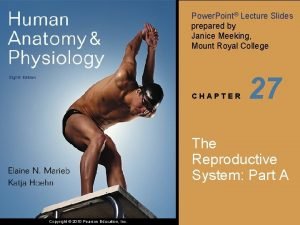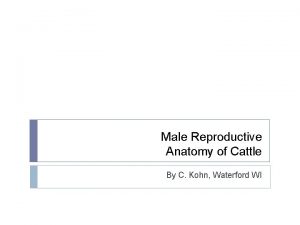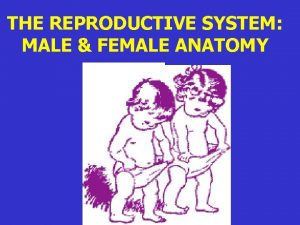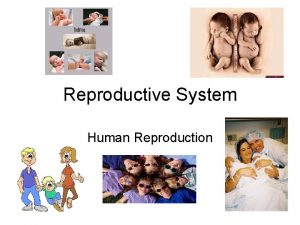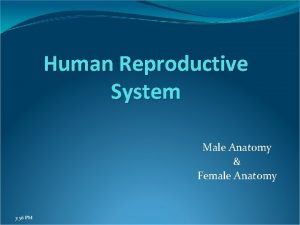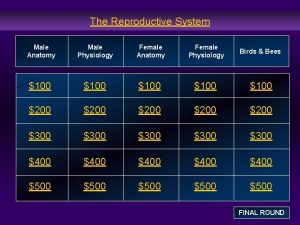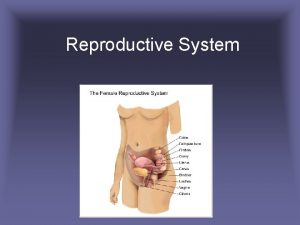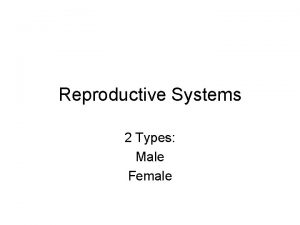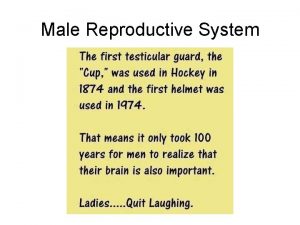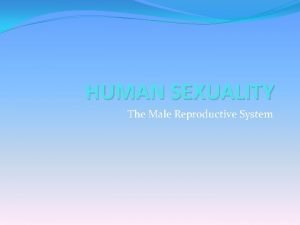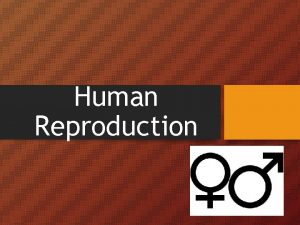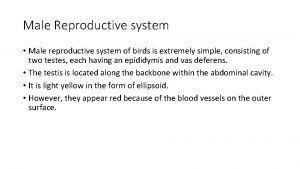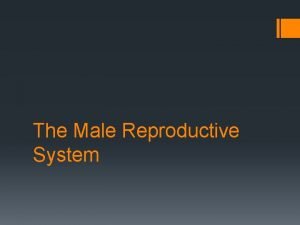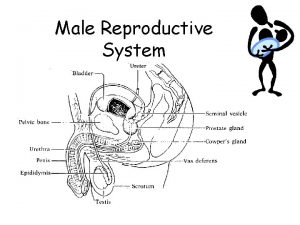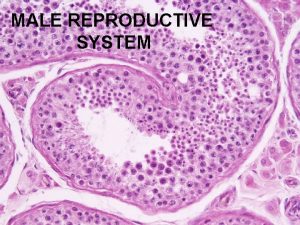Human Reproductive System Male Anatomy Female Anatomy 7



























- Slides: 27

Human Reproductive System Male Anatomy & Female Anatomy 7: 20 AM

2 / 26 or 29/ 2016 Agenda Pass out 1 chrome book for every 2 people. (You ma sit in groups of 2 of your choice, after roll call. ) Everyone gets their own worksheet. You will also be using your notebook, page 35 L & R Complete Anatomy Power. Point. Staple completed hand out on page 35 R Return ALL chrome books to the cart before the end of the period. There should be 28!

Catalyst: What conversations Male & Female 2/26/16 Reproductive System have you already had about reproductive health and with whom? (Please try and be as thoughtful as possible, write 5 or more complete sentences) Reflection: 35 L 35 R Mrs. Degl

Visit the link for information on the: female reproductive system http: //www. childrenscolorado. org/wellness -safety/health-library/forkids/interactive/flash-interactive-bodybasics-female-reproductive-system Complete your handout by correctly labeling the organs and writing down their functions (jobs) in your own words

Visit the link for information on the: male reproductive system http: //www. childrenscolorado. org/wellness -safety/health-library/forteens/interactive/flash-interactive-bodybasics-male-reproductive-system Complete your handout by correctly labeling the organs and writing down their functions (jobs) in your own words

Staple your anatomy worksheet on to 35 R of your notebook! 1/5/2022

Cornell Notes Please take Cornell notes on page 35 R on the information provided on the following slides. You are welcome to read more on the female reproductive system or other reproductive health topics at: http: //kidshealth. org/en/teens/femalerepro. html? WT. ac=ctg#catchanging-body You are welcome to read more on the male reproductive system or other reproductive health topics at: http: //kidshealth. org/en/teens/malerepro. html? WT. ac=ctg#catchanging-body

Check out how to complete Cornell notes 35 R In your notebook

Hormones chemical messengers produced by the body to regulate body functions Two hormones in particular cause the changes we experience during puberty Estrogen Testosterone 7: 21 AM

Estrogen Responsible for female sex traits Help regulate female reproductive cycle Produced by the ovaries Testosterone Responsible for male sex traits Plays an important role in the production of sperm Produces by the testes These hormones are produced in BOTH males and females but in different amounts. 7: 21 AM

Prostate Gland Vas Deferens Penis Epididymis Urethra 7: 21 AM Testes scrotum Check your work sheet

Male Reproductive Organs (6) 1. Testes – produces sperm cells and testosterone 2. Epididymis – network of tubes behind testes that store sperm 3. Vas Deferens – a long thin tube that sperm travel through in the urethra 4. Prostate Gland – reproductive organ that produces a fluid to help sperm move 5. Urethra – narrow passageway inside the penis through which semen and urine leave the body 6. Penis – a muscular structure that helps transfer sperm to female’s reproductive tract

Sperm Cells • The testicles produces about 200 million sperm in one day! • A male can produce healthy sperm for the rest of his life. Between 300 million and 500 million sperm are normally released during a single ejaculation. 7: 21 AM

Spermatogenisis Sperm production begins at puberty at continues throughout life, with several hundred million sperm being produced each day. Once sperm form they move into the epididymis, where they mature and are stored. Human Sperm (SEM x 5, 785). This image is copyright Dennis Kunkel at www. Dennis. Kunkel. com, used with permission.

tube egg travels through to uterus contains female egg cells muscular organ where fertilized egg develops opening to the uterus muscular passageway that leads from outside the body to the uterus 7: 21 AM

Organs of the Female Reproductive System Vagina: also called the birth canal, a tube leading from the uterus to the outside of the body. Cervix: the lower portion of the uterus; where the vagina and uterus meet. Uterus: a hollow, fist-sized organ located between the bladder and rectum. Fallopian Tubes: also called oviducts; are two tubes connecting the uterus with the ovaries.

Organs of the Female Reproductive System Ovaries: small organs on the ends of the Fallopian tubes responsible for the production and release of eggs (ova-pl). Females are born with all of the eggs they will ever produce. Ovaries alternate the release of eggs each month. Like testes, the ovaries produce hormones-estrogen. This release of the ova is called ovulation.

Egg Cells Only one sperm cell can enter one egg cell. Unlike males, females are born with a limited number of egg cells. 7: 21 AM

Human Reproduction Male reproductive organ, the testes, produces sperm cells Female reproductive organ, the ovaries, produces egg cells Fertilization occurs inside the female body The union of sperm and egg produces an embryo (a BABY) 7: 22 AM

The Menstrual Cycle and Fertilization If the egg is fertilized by a sperm cell, the egg will implant in the lining of the uterus and begin to develop. Zygote: The first cells of a new organism; the time from fertilization to implantation. Embryo: The zygote is called an embryo from implantation to 8 weeks. Fetus: After 8 weeks of development, the embryo is known as a fetus.

Twins Multiple eggs are released or there is more than one ovulation. Both (or more) eggs are fertilized and you have fraternal twins. One egg is released but splits in two. Identical twins are made. If the egg does not completely split in two, conjoined twins are produced.

Menstruation (“Period”) Menstruation – the flow of the uterine lining material from the body Menstruation may start as soon as a girl reaches puberty Ovulation – process by which the ovaries release a single mature egg every 28 days 7: 22 AM

Fallopian tube Uterus ovary cervix vagina 7: 22 AM

The Menstrual Cycle After menstruation, the ovaries release hormones that tell the uterus to grow a new lining and prepare to receive a new egg. As the uterus prepares a new lining, one of the ovaries releases an egg. This is called ovulation. Ovulation occurs about halfway through a woman’s cycle. The egg travels through the Fallopian tube. If it is not fertilized it breaks down and is released with the lining and blood of the uterus.

Pads & Tampons Females release about 35 ml of blood and tissue during menstruation. 7: 22 AM

Menopause? Most women enter menopause between the ages of 46 and 54. They stop ovulating and no longer have menstrual cycles. No longer capable of carrying and giving birth, naturally, to a child. 7: 22 AM

Male & Female 2/26/16 Reproductive System Catalyst: What conversations have you already had about reproductive health and with whom? (Please try and be as thoughtful as possible, write 5 or more complete sentences) Reflection: What is one new thing you learned about your body today? What is one question you have? 35 L 35 R Mrs. Degl
 Male and female reproductive system
Male and female reproductive system Male fallopian tube
Male fallopian tube Differences between male and female reproductive organ
Differences between male and female reproductive organ 90/2
90/2 Penis circumcised
Penis circumcised Cartilaginous fish reproduction
Cartilaginous fish reproduction Sheep reproductive system
Sheep reproductive system Falopian tube parts
Falopian tube parts Ovarian duct
Ovarian duct Prosted
Prosted Where is the vulver
Where is the vulver Fallopian tube
Fallopian tube Aphi sada u rat yaya
Aphi sada u rat yaya Function of the vagina
Function of the vagina Examination of reproductive system
Examination of reproductive system Exercise 42 anatomy of the reproductive system
Exercise 42 anatomy of the reproductive system Oogenesis process
Oogenesis process Copyright
Copyright The reproductive system chapter 16
The reproductive system chapter 16 Reproductive physiology
Reproductive physiology Male plant reproductive system
Male plant reproductive system Art-labeling activity: the male reproductive system, part 1
Art-labeling activity: the male reproductive system, part 1 Male reproductive system information
Male reproductive system information Reproductive organ
Reproductive organ Bull reproductive system parts and functions
Bull reproductive system parts and functions Asexual reproduction
Asexual reproduction Disease traductor
Disease traductor Reproductive system of pila
Reproductive system of pila


